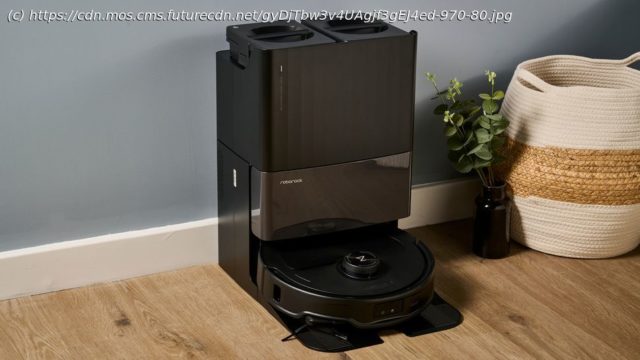Top tips from TechRadar’s resident robovac expert
A great robot vacuum can save you both time and effort. As a TechRadar Homes Editor specializing in floor-cleaning appliances, I spend plenty of time reading and writing about the latest robot vacuums developments, as well as testing a range of models at different price points.
Today’s very best robot vacuums can arrive with a War and Peace-length features list, and figuring out what it all means can be tricky. Especially since brands in this space tend to shy away from easily comparable specs in favor of long descriptions and impressive-sounding jargon.
Below, I’ll run through the various features of robot vacuum cleaners, unpacking the jargon to help clarify what each one does. Read on to discover an easy to understand guide that will ultimately help you find the right model of robot vacuum for you. Suction power
Figuring out how much suction a vacuum cleaner offers can be a surprisingly tricky process when it comes to manual models. Thankfully, it tends to be more straightforward with robot vacuums, since most brands will publish these specs. Measured in pascals (Pa), the figure refers to how much air pressure the machine can create – and, as a result, how much force with which it pulls up dust and debris.
Today’s top-specced robovacs, such as the Ecovacs Deebot T30S Combo (pictured), can generate upwards of 10,000Pa of suction. That’s rare, however; for that kind of power, you’d be looking to pay a price that’s four figures. In the mid-range, expect 5,000-7,000Pa of suction. Lower than 5,000Pa is what I’d expect in a budget-friendly model.
Although Pa figures can be a useful initial indicator of suction power, it isn’t the be-all and end for cleaning. Bear in mind that these specs reference the maximum suction; it’s unlikely you’ll be doing a regular cleaning session at that rate.
Design aspects such as the brushroll type, edge cleaning features and – on more premium models – smart suction adjustment also play a part in how well a robot vacuum cleans. I suspect this is the justification for the brands that don’t publish suction stats (looking at you, iRobot Roomba).
It’s also worth noting that robot vacuums are really designed for convenient, light cleans that are carried out regularly. For a deep clean, you’ll probably need to keep one of the best manual vacuums to hand.Mopping functionality
Many of today’s best robot vacuums can also mop floors. And you might be more surprised to learn that brands appear to be increasingly moving away from vacuum-only robots, focusing on combo models in their new releases.
Robot vacuum mopping capabilities remain quite limited compared to what you’d be able to achieve with a standard mop and some elbow grease; don’t expect such a cleaner to really scrub your floors. However, for regular, light cleans, a combo robot vacuum and mop can be effective.
There are two common mop types: a semicircular mop pad that presses down and/or vibrates as it cleans, or two flat disc-shaped mop pads that rotate. In my experience, the latter tend to be more effective at cleaning.
Other things to factor in when considering a vacuum with a mop function is the level of downward pressure the mop pads apply while cleaning, and if the model has a means for tackling edges. Additional side mops are rarer than side brushes, but not unheard of (the Roborock S8 MaxV Ultra has one, for instance) and the Dreame L40 Ultra – review in progress – has a mop that can shift out to the side to clean the edges of rooms.
If you have some deep-pile carpets or thick rugs, check what the robot vacuum does with the mop when it’s not mopping. Most robovacs can lift up their mop pads to avoid cross-contamination from hard floor to carpet.
More advanced models such as the Dreame L40 Ultra and the Samsung Bespoke Jet Bot Combo AI have pads that attach magnetically, leaving them in the dock when just a vacuum is required. The Robot Roomba Combo J7 Plus has a mop pad that repositions itself on top of the robot body when it isn’t in use.
Combo models are generally more expensive than vacuum-only robots. Some brands, such as iRobot, will offer vac-only or combo versions of the same model, meaning you can pick the one that suits your needs and budget.
Pricier self-empty models will arrive with a dock that’s able to empty and refill the onboard water tanks (more on that in the Dock section), but basic models will likely require you manually swap the dust bin for a water tank when switching from vacuum to mop mode.Robot height and clearance
Robot height is relevant if you have low (but not too low) furniture. A robot with a relatively reduced height will be able to clean right under your sofa and other furniture, saving you a huge amount of effort.
We’re yet to see a robot that can climb stairs. Almost all will come equipped with cliff sensors that help them identify and avoid any changes of floor level, so while you won’t have to deal with your robovac flinging itself down your stairs, you will have to come up with an alternative vacuuming solution if you live in a multi-floor home.
While stair-climbing remains a distant dream, brands are increasingly focused on pushing the boundaries of what their robovacs can get over. High thresholds or chunky rugs can easily beach a robot vacuum, requiring manual rescuing and negating many of the benefits of this ostensibly hands-off cleaning solution.
The Roborock Qrevo Curv (shown above, review in progress) has quadbike-like suspension to bounce it over obstacles, and a number of other brands have come up with alternative solutions.






